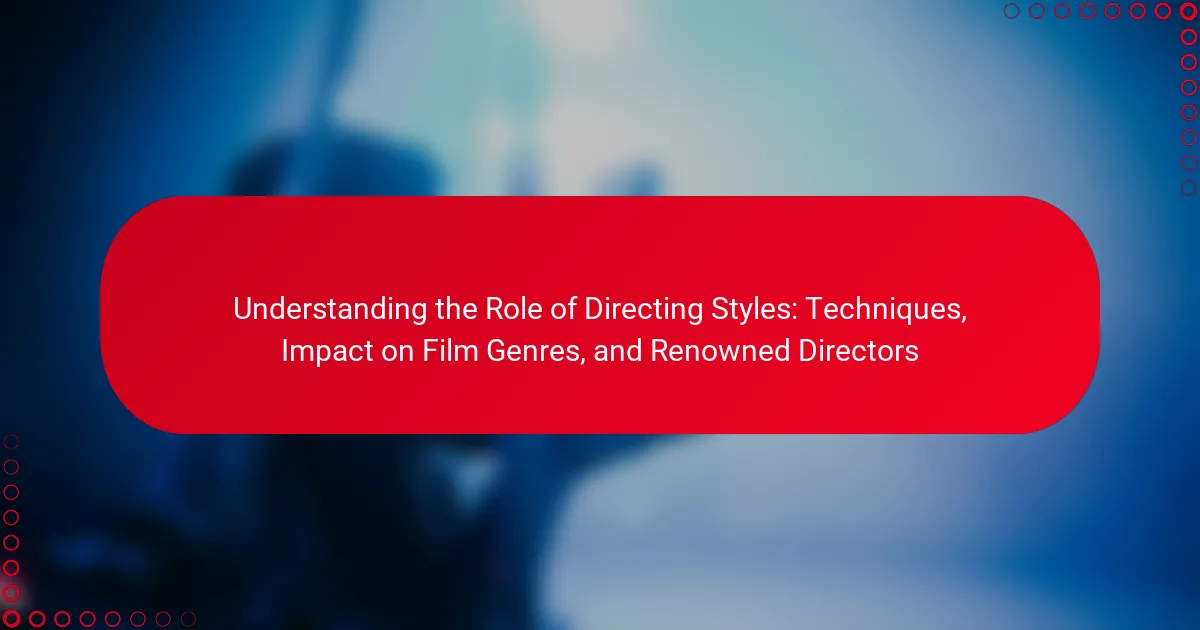Directing styles are the unique approaches that film directors employ to express their vision and enhance storytelling. These styles, which include collaborative, authoritarian, minimalist, dynamic, surreal, and improvisational techniques, significantly affect a film’s tone, pacing, and audience engagement. The article explores how directing styles shape various film genres and highlights the contributions of renowned directors such as Alfred Hitchcock, Martin Scorsese, and Quentin Tarantino, each known for their distinctive techniques and lasting impact on cinema. Understanding these directing styles is essential for appreciating their role in defining a film’s emotional resonance and effectiveness.

What are Directing Styles and Why are They Important?
Directing styles are the distinctive approaches directors use to convey their vision in film. They encompass techniques, methods, and philosophies that shape storytelling. Different styles can significantly impact a film’s tone, pacing, and audience engagement. For example, a director may prefer a collaborative style, involving actors in the creative process, or a more authoritarian style, where they maintain strict control over every aspect.
The importance of directing styles lies in their ability to influence the overall effectiveness of a film. They help establish a unique voice for the director and can define a film genre. Renowned directors like Alfred Hitchcock and Quentin Tarantino are known for their specific styles, which have left lasting impressions on cinema. Studies show that a director’s style can enhance the emotional resonance of a film, making it memorable for viewers.
How do Directing Styles Influence Film Production?
Directing styles significantly influence film production by shaping the creative vision and execution of a film. Each style, such as auteur, collaborative, or improvisational, dictates how a director interacts with the cast and crew. For instance, auteur directors often maintain tight control over all aspects of production, ensuring their unique vision is realized. This can lead to a distinct visual and narrative style that is recognizable across their body of work.
Collaborative styles encourage input from various departments, fostering a more inclusive creative environment. This approach can enhance the storytelling process by integrating diverse perspectives and expertise. Improvisational directing allows actors to explore their characters more freely, which can lead to unexpected and authentic performances.
Historical examples illustrate these influences. Alfred Hitchcock’s meticulous planning exemplifies the auteur style, resulting in suspenseful films with precise pacing. In contrast, directors like Mike Leigh utilize improvisation, leading to organic narratives that resonate with audiences. Thus, directing styles fundamentally shape the production process, impacting everything from script development to final editing.
What are the key characteristics of various Directing Styles?
Directing styles are categorized methods filmmakers use to convey their vision. Each style has distinct characteristics that impact storytelling and visual presentation.
The auteur style emphasizes the director’s personal vision and creative control. Directors like Alfred Hitchcock and Quentin Tarantino exemplify this approach. Their unique perspectives shape the narrative and aesthetic.
The collaborative style focuses on teamwork and input from various departments. Directors such as Steven Spielberg often utilize this method. This approach fosters a shared vision among cast and crew.
The documentary style aims for realism and authenticity. Directors like Ken Burns use this style to present factual narratives. This method often includes interviews and real-life footage to enhance credibility.
The experimental style breaks conventional norms. Directors such as David Lynch challenge traditional storytelling. This approach often results in non-linear narratives and abstract visuals.
The commercial style prioritizes audience appeal and marketability. Directors like Michael Bay create visually engaging blockbusters. This style often focuses on action and spectacle to attract viewers.
How do Directing Styles affect the creative process?
Directing styles significantly influence the creative process in filmmaking. Each style shapes how a director communicates vision to the cast and crew. For instance, an authoritarian style may limit collaboration, while a collaborative style encourages input from team members. This affects the overall tone and direction of the project.
Directors like Alfred Hitchcock used a more controlling approach, ensuring precise execution of their vision. In contrast, directors such as Mike Leigh favor improvisation, which can lead to unexpected creative outcomes. Research shows that collaborative directing can enhance creativity by fostering a more open environment for ideas.
A study by the University of Southern California found that directors who engage their teams in decision-making can produce more innovative results. Thus, the choice of directing style directly impacts the creative dynamics and final output of a film.
What Techniques are Commonly Used in Different Directing Styles?
Different directing styles utilize distinct techniques to convey their artistic vision. For instance, in a naturalistic style, directors often focus on realistic dialogue and settings. This approach aims to create an authentic experience for the audience. Conversely, in expressionistic directing, stylized visuals and exaggerated performances are common. This technique emphasizes emotional impact over realism.
In documentary directing, techniques such as interviews and real-life footage are frequently employed. This style aims to inform and engage viewers through factual storytelling. Additionally, in the avant-garde style, unconventional narrative structures and experimental techniques are often used. This approach challenges traditional storytelling norms.
Each directing style employs these techniques to evoke specific emotional responses and convey unique messages. By analyzing these methods, one can better understand the diverse landscape of film directing.
How do directors implement specific techniques in their work?
Directors implement specific techniques through careful planning and execution of visual storytelling elements. They utilize camera angles, lighting, and shot composition to convey emotions and themes. For instance, low-angle shots can create a sense of power, while high-angle shots may evoke vulnerability. Directors also employ editing techniques, such as pacing and transitions, to enhance narrative flow. The use of sound design and music further supports the emotional tone of scenes. Notably, Alfred Hitchcock used suspenseful techniques like the “MacGuffin” to drive plot engagement. Directors often adapt techniques based on genre conventions, ensuring their work resonates with audiences.
What role does collaboration play in these techniques?
Collaboration is essential in directing techniques as it brings together diverse creative inputs. Directors rely on the expertise of cinematographers, editors, and actors to enhance their vision. Effective collaboration fosters innovation and allows for the blending of different artistic perspectives. This synergy can lead to more compelling storytelling and visual aesthetics. Historical examples include the partnerships of directors like Martin Scorsese and editor Thelma Schoonmaker, who have worked together to create iconic films. Their collaboration has resulted in a unique narrative style that resonates with audiences. Thus, collaboration significantly enriches the filmmaking process and the effectiveness of directing techniques.

How do Directing Styles Impact Different Film Genres?
Directing styles significantly influence the tone and storytelling of different film genres. For instance, a minimalist directing style often enhances the emotional weight in drama films. This approach allows actors’ performances to shine without excessive visual distractions. In contrast, a dynamic directing style is prevalent in action films. It employs fast cuts and movement to build excitement and tension.
Moreover, a surreal directing style is commonly found in fantasy and horror genres. This style creates an otherworldly atmosphere that heightens the sense of fear or wonder. In comedies, a more improvisational directing style can lead to spontaneous humor and relatable characters. Each genre thus utilizes specific directing styles to shape audience experience and narrative effectiveness.
What are the relationships between Directing Styles and Film Genres?
Directing styles significantly influence film genres. Each directing style brings unique techniques and storytelling methods. For instance, a documentary style often emphasizes realism, enhancing genres like biopics and documentaries. In contrast, a surrealistic directing style can transform a narrative into a fantasy or horror genre.
Directors like Alfred Hitchcock utilized suspenseful techniques, shaping the thriller genre. Similarly, Wes Anderson’s distinct visual style defines his work within the comedy and drama genres. Historical context also shows that genre evolution often aligns with shifts in directing styles.
The relationship between directing styles and film genres is evident in how directors shape audience perceptions through their chosen techniques. This interplay is fundamental to the storytelling process in cinema.
How do specific Directing Styles shape genre conventions?
Specific directing styles significantly influence genre conventions by establishing unique narrative and visual frameworks. For instance, the use of realism in directing often aligns with drama genres, emphasizing character development and emotional depth. This approach can be seen in the works of directors like Ken Loach, who employs naturalistic techniques to enhance storytelling.
Conversely, stylized directing, such as in the works of Quentin Tarantino, shapes genres like action or thriller by incorporating non-linear narratives and heightened dialogue. This creates a distinct genre identity that deviates from traditional storytelling methods.
Additionally, the use of specific cinematographic techniques, such as handheld camera work in horror films, intensifies the viewer’s experience and heightens suspense. Directors like John Carpenter have utilized this method effectively to establish genre-specific conventions.
Overall, directing styles dictate how stories are told within genres, influencing audience expectations and engagement.
What examples illustrate the impact of Directing Styles on genre?
Directing styles significantly influence film genres through distinctive techniques and narrative approaches. For instance, Alfred Hitchcock’s suspenseful directing style is pivotal in the thriller genre. His use of tension-building techniques, such as the ‘MacGuffin’ plot device, creates suspenseful narratives. Similarly, Wes Anderson’s unique visual aesthetic and symmetrical compositions shape the quirky comedy genre. His films often feature whimsical characters and offbeat storytelling. Additionally, Martin Scorsese’s gritty realism and dynamic camera movements are essential to the crime genre. His work often explores themes of morality and power, enhancing the genre’s depth. These examples demonstrate how directing styles can shape genre conventions and audience expectations.
Why is it essential to understand Directing Styles in Film Analysis?
Understanding directing styles in film analysis is essential for interpreting the filmmaker’s vision. Directing styles shape narrative structure, character development, and visual storytelling. They influence audience engagement and emotional response. Different styles, such as realism or expressionism, create distinct viewing experiences. Recognizing these styles aids in critical evaluation of films. It also enhances appreciation of cinematic techniques and artistic choices. Film scholars and critics emphasize the importance of directing styles in understanding thematic depth. Analyzing these styles provides insight into cultural and historical contexts of films.
How can analyzing Directing Styles enhance viewer experience?
Analyzing directing styles enhances viewer experience by providing insights into the filmmaker’s vision. Different directing styles influence narrative pacing, visual storytelling, and character development. For instance, a director like Alfred Hitchcock uses suspenseful techniques to engage audiences emotionally. Understanding these styles allows viewers to appreciate the artistic choices behind scenes. It also fosters deeper connections with the story and characters. Studies show that viewers who analyze directing styles report higher satisfaction and engagement. An example is the use of long takes in the works of directors like Andrei Tarkovsky, which creates a meditative viewing experience. Thus, analyzing directing styles enriches overall film appreciation and enjoyment.
What insights can be gained from studying Directing Styles?
Studying directing styles provides insights into the creative choices directors make in storytelling. Each directing style influences the film’s tone, pacing, and audience engagement. For example, a minimalist style may focus on character development, while a stylized approach can enhance visual storytelling. Understanding these styles helps analyze how films convey themes and emotions. Directors like Alfred Hitchcock and Quentin Tarantino exemplify distinct styles that shape viewer experiences. Analyzing their techniques reveals the impact of direction on genre conventions and audience reception. This knowledge is crucial for aspiring filmmakers and critics to appreciate cinematic artistry.

Who are Some Renowned Directors and What are Their Styles?
Some renowned directors include Alfred Hitchcock, Martin Scorsese, and Quentin Tarantino. Alfred Hitchcock is known for his suspenseful storytelling and innovative camera techniques. His films often feature psychological themes and unexpected twists. Martin Scorsese is recognized for his gritty realism and exploration of crime and morality. He frequently collaborates with actors like Robert De Niro and Leonardo DiCaprio. Quentin Tarantino is famous for his non-linear narratives and sharp dialogue. His films often pay homage to various genres, blending elements of action, drama, and humor.
What are the distinctive Directing Styles of famous filmmakers?
Famous filmmakers exhibit distinctive directing styles that define their cinematic approach. Alfred Hitchcock is known for his suspenseful storytelling and innovative camera techniques. Quentin Tarantino employs nonlinear narratives and sharp dialogue. Stanley Kubrick is recognized for his meticulous attention to detail and visual composition. Martin Scorsese often utilizes dynamic editing and a strong sense of rhythm in his films. Wes Anderson’s style is characterized by symmetrical compositions and vibrant color palettes. Each director’s unique style contributes significantly to their storytelling and the overall impact of their films.
How do these directors’ styles reflect their personal vision?
Directors’ styles reflect their personal vision through unique storytelling techniques and visual aesthetics. Each director employs specific methods to convey themes and emotions. For example, Alfred Hitchcock’s suspenseful narratives showcase his fascination with psychological tension. Similarly, Wes Anderson’s symmetrical compositions highlight his whimsical and nostalgic storytelling approach. Directors often draw from personal experiences, cultural backgrounds, and artistic influences. This results in distinct cinematic signatures that resonate with audiences. Their choices in color palettes, camera angles, and pacing further emphasize their artistic intentions. Thus, the combination of these elements creates a cohesive representation of their personal vision in film.
What techniques do renowned directors use to convey their style?
Renowned directors use various techniques to convey their unique styles. These techniques include specific camera angles, lighting choices, and editing styles. For example, Alfred Hitchcock often employed suspenseful framing and close-ups to heighten tension. Quentin Tarantino is known for his non-linear storytelling and sharp dialogue. Wes Anderson utilizes symmetrical compositions and vibrant color palettes to create whimsical atmospheres. Martin Scorsese frequently uses tracking shots and dynamic editing to enhance narrative flow. These stylistic choices help distinguish each director’s work and influence audience perception.
How have Renowned Directors influenced the evolution of Directing Styles?
Renowned directors have significantly influenced the evolution of directing styles through innovative techniques and unique storytelling approaches. Directors like Alfred Hitchcock introduced suspense and psychological depth, reshaping narrative structures. Orson Welles revolutionized cinematic language with deep focus and non-linear storytelling in “Citizen Kane.” Akira Kurosawa’s use of composition and movement influenced action and drama genres, impacting filmmakers worldwide. The French New Wave directors, such as Jean-Luc Godard, challenged traditional filmmaking norms, emphasizing spontaneity and personal expression. These directors set trends that led to the emergence of new styles, such as neo-realism and postmodernism. Their contributions have created a diverse landscape of directing styles that continue to evolve.
What are some pivotal moments in directing history?
The introduction of sound in film marked a pivotal moment in directing history. In 1927, “The Jazz Singer” became the first synchronized sound feature. This innovation transformed storytelling techniques in cinema. Directors had to adapt their styles to incorporate dialogue and sound effects. The rise of Hollywood’s studio system in the 1930s further shaped directing practices. Directors like Frank Capra and Alfred Hitchcock became influential figures during this era. The emergence of the French New Wave in the 1950s challenged traditional filmmaking conventions. Directors such as François Truffaut and Jean-Luc Godard emphasized personal expression and experimentation. The digital revolution in the late 20th century also significantly impacted directing. Filmmakers gained new tools for editing and visual effects. Each of these moments has played a crucial role in evolving the art of directing.
How have these directors shaped contemporary filmmaking?
These directors have significantly shaped contemporary filmmaking through innovative techniques and storytelling methods. Their unique styles have influenced narrative structures and visual aesthetics. For instance, directors like Quentin Tarantino and Christopher Nolan have popularized non-linear storytelling. Their films often challenge traditional plot progression, engaging audiences in new ways. Additionally, directors such as Greta Gerwig and Jordan Peele have brought diverse perspectives to mainstream cinema. This has expanded the representation of marginalized voices in film. Their contributions have led to a broader understanding of genre and audience expectations. Consequently, contemporary filmmaking reflects a richer tapestry of cultural narratives and artistic expression.
What Practical Tips Can Aspiring Directors Learn from Established Styles?
Aspiring directors can learn several practical tips from established directing styles. First, they should study the techniques used by renowned directors. For example, Alfred Hitchcock’s use of suspense can teach the importance of pacing. Secondly, understanding the visual storytelling of directors like Wes Anderson emphasizes the significance of aesthetics. Additionally, analyzing the character development methods of directors such as Martin Scorsese can highlight the value of deep character arcs.
Moreover, aspiring directors should experiment with different styles to find their unique voice. Learning from the collaborative processes of directors like Steven Spielberg can foster teamwork and communication skills. Finally, observing how established directors handle feedback can improve their adaptability and resilience in the industry. Each of these tips is grounded in the practices of successful filmmakers, providing a roadmap for emerging directors.
How can understanding Directing Styles improve a director’s craft?
Understanding directing styles enhances a director’s craft by providing frameworks for storytelling and character development. Different styles, such as realism or expressionism, inform choices in scene composition and actor direction. This knowledge allows directors to create a cohesive vision that resonates with audiences. Research shows that directors who adapt their styles to suit narratives can significantly improve film reception. For instance, Alfred Hitchcock’s mastery of suspense through specific techniques illustrates the impact of style on viewer engagement. By grasping various directing styles, directors can refine their artistic voice and elevate their work.
What resources are available for studying Directing Styles?
Books on directing styles include “Directing Actors” by Judith Weston and “The Director’s Craft” by Katie Mitchell. Online courses from platforms like MasterClass and Coursera offer insights on directing techniques. Film schools often provide specialized programs focusing on directing styles. Documentaries and interviews with renowned directors also serve as valuable resources. Additionally, academic journals publish research on directing styles and their impact on film genres. Websites like IndieWire and No Film School feature articles and discussions on contemporary directing practices.
The main entity of the article is directing styles, which are the distinct approaches filmmakers use to convey their vision in cinema. The article explores how these styles impact storytelling, film production, and audience engagement, highlighting various techniques and characteristics associated with different directing styles such as auteur, collaborative, documentary, and experimental. It also examines the influence of renowned directors like Alfred Hitchcock and Quentin Tarantino on the evolution of directing styles and their relationship with film genres. Additionally, the article discusses the importance of understanding directing styles for film analysis and offers practical tips for aspiring directors to enhance their craft.
